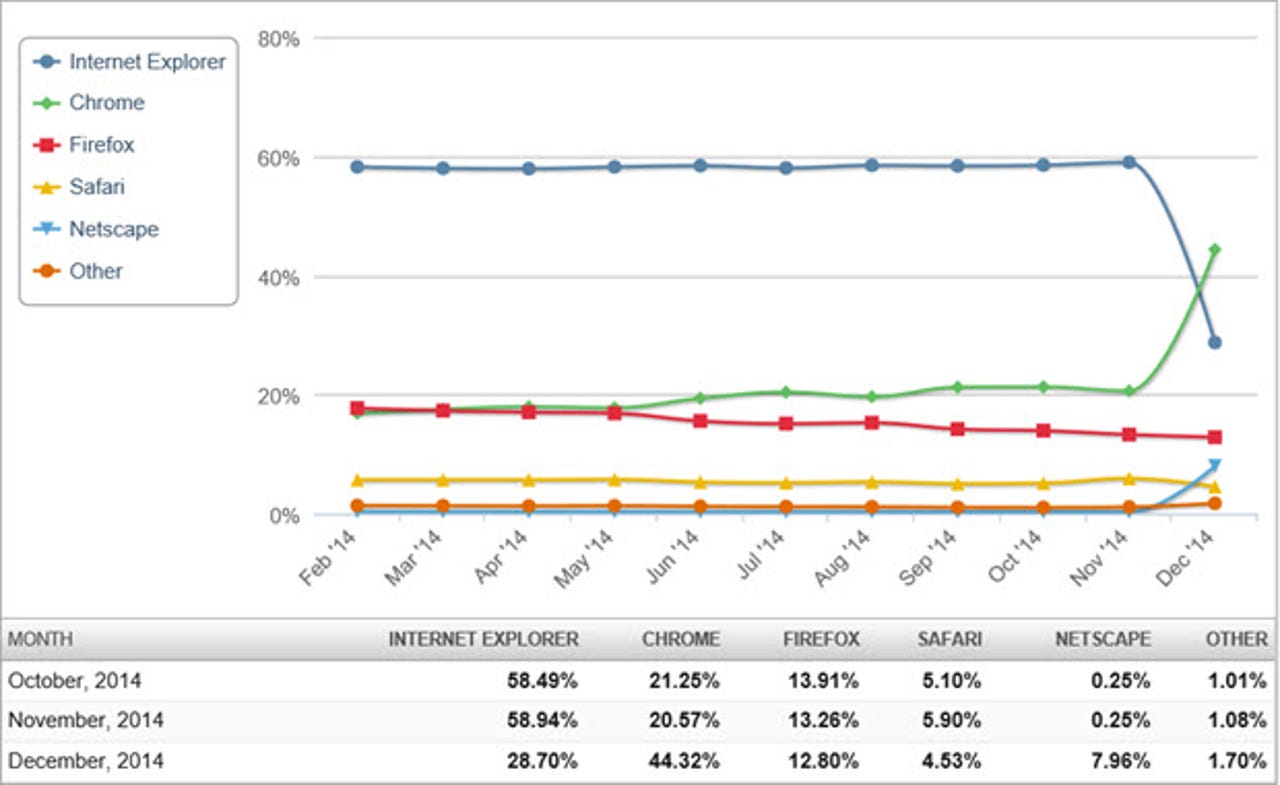Web analytics firms kick off New Year with more suspicious statistics

Oops, they did it again.
Yesterday, as is its custom on the first day of the month, the analytics firm Net Applications (aka Net Market Share) published its monthly report on worldwide usage of web browsers and operating systems. Apparently, December 2014 was a time of great transformation, with hundreds of millions of people suddenly changing their computing habits almost literally overnight.
Here, for example, is what initially appeared on the Desktop Top Browser Share Trend page:

No, those numbers make no sense. Netscape Navigator, a product that died more than a decade ago, did not suddenly reappear on 1 in every 12 computers worldwide in an HTTP-powered Zombie Apocalypse, nor did several hundred million people suddenly decide to drop Internet Explorer and begin using Chrome.
Today, that chart has been replaced with this more plausible-looking version:
In an emailed statement, a spokesperson for Net Applications says the firm is "in the middle of an upgrade to the entire system, both on the data collection side, and reporting. There will be a couple of months where we have to work through the changes..."
That's an understatement.
This is only the latest example in an embarrassing string of recent miscues and hasty adjustments from Net Applications, whose numbers have become widely reported by ZDNet and other data-hungry tech-focused news outlets.
In October, the company reported a sudden drop in Windows XP usage and, after questioning, published an update acknowledging that the apparently newsworthy change occurred because they had made an adjustment to de-skew the data from "a group of large Chinese publishers" whose visitors almost exclusively use Windows XP.
For November, the plunge in XP usage apparently continued as Windows 8.x usage surged, although my colleague Jack Schofield was appropriately skeptical of the numbers: "I'm pretty sure it's not real," he reported.
And I am equally certain that this month's numbers are also science fiction. Here, see for yourself:
All those people who were surging to Windows 8 and 8.1 have apparently quit their experiment and gone back to Windows XP. Given the sales momentum for current Windows PCs, this month should have seen Windows 8/8.1 approach the 20 percent mark in total.
Instead, that share plunged in December, meaning that something like 50 million people worldwide gave up on Windows 8.1 last month if the Net Applications data is to be believed.
Spoiler alert: Don't believe that data. The numbers that appear today have been adjusted from yesterday's totals. I am certain that further adjustments are in order as well.
And don't go looking to Net Applications' rival, StatCounter, for numbers that are any less squishy. Here, for example, are StatCounter's latest figures for browser usage in North America.
I'm sure Microsoft's product managers are high-fiving one another over their ability to convince 10s of millions of North American PC users to switch back to Internet Explorer in the past 60 days. And Chrome's product managers are trying to figure out what went so wrong and how they suddenly lost a huge lead.
Or they would be, if this literally unbelievable data were true. Which it isn't.
Meanwhile, the inexplicable rise of the Qihoo Safe 360 browser appears to have ended. According to StatCounter, this obscure Chinese product had soared to fifth place in North America in 2014, and they defended their data vigorously when I questioned it.
Strangely enough, the month after I posted those questions, the numbers for Safe 360 plummeted.
Look, all tech reporters love data. It's the raw material we spin into articles. But it's become painfully clear in recent months that the numbers we are fed each month are horribly flawed, and the problem is getting worse.
If the companies involved won't stop publishing this silly data, maybe it's time for the tech press to stop playing along and retire those monthly reports.